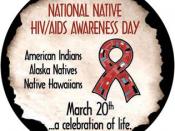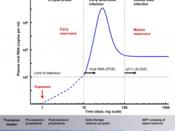AIDSAIDS stands for "Acquired Deficiency Syndrome."ÃÂ It is an extremely virulent sexually transmitted disease that renders the immune system inoperative. AIDS is caused by HIV (Human Immunodeficiency Virus). HIV weakens the immune system until the person is diagnosed with AIDS. However, not all people with HIV get AIDS. Since 1981, when AIDS was first recognized, forty-seven million people in the world have been infected and fourteen million has died. AIDS is the fifth leading cause of death among the ages of twenty-five and forty-four in the United States. There are no symptoms of HIV. You cannot tell by looking at a person. The only way to tell is if you get tested.
CAUSES There are three ways the virus can be transmitted. The first way is through sexual contact, such as, orally, vaginal, and anal. Next, the virus can be transmitted through blood transplants or needle sharing.
Finally, the mother can transmit the virus to her child. For example, a pregnant mother gives it to her fetus, or when she nurses her baby. A person cannot get AIDS by casual touching, such as, shaking hands, hugging, or sitting on toilet seats. People at the highest risk are homosexual and bisexual men, drug users who share needles, and people who need blood transfusions. As the infection progresses, some symptoms can include: swollen lymph glands in the neck, underarm, or groin area, recurrent fever including "night sweats," rapid weight loss for no apparent reason, constant tiredness, diarrhea and decreased appetite, white spots or unusual blemishes in the mouth.
PREVENTION In order to prevent AIDS, you should not have sex with people known or suspected to have AIDS, multiple partners, have sex with someone who has multiple partners, or people who us IV drugs (needles). Pregnant women can prevent their child from having cancer if they use antiviral medication, keep the delivery short, and if the child is already born, avoid breast-feeding.
WOMEN AND AIDS From 1985 through 1997, there was an increase from seven percent to twenty-two percent AIDS cases in American women. Thirteen to twenty-four year olds account for seventy-six percent of AIDS cases among women in America. HIV positive are more common in women than in men.
SYMPTOMS Symptoms of AIDS in women include, re-occurring yeast infections, pelvic inflammatory disease, abnormal changes or growth and presence of pre-cancerous cells in the cervical tissue, genital ulcers, genital warts, and severe muscular herpes infections. The most common symptoms of exposure to the HIV virus are frequent or severe vaginal infections, abnormal PAP smears, or pelvic infections (PID) that are difficult to treat. It is also important for HIV-infected women and their physicians to watch for pelvic inflammatory disease or other STDs through screening.
TREATMENTS Medications for treating AIDS include: those for antiviral treatment and other drugs, like oral anti-fungal to combat yeast infections, which fight diseases that take advantage of the weakened immune response of HIV-infected people. Doctors have not come up with a treatment that will cure the AIDS virus yet. Medicines to fight AIDS need to be developed to kill the viruses, but not the cells that the viruses live in.
WORKS CITED www.time.com/time/2001/aidsinafrica/photo.html www.jama.ama-assn.org www.hivatis.org www.missoula.bigsky.net/ravasaids/ www.avert.org/statindx.htm www.botbot.com Access to Health. Davis, Lorraine G., Donatelle, Rebecca J. Pearson Education Company. 2000. Sixth edition.





